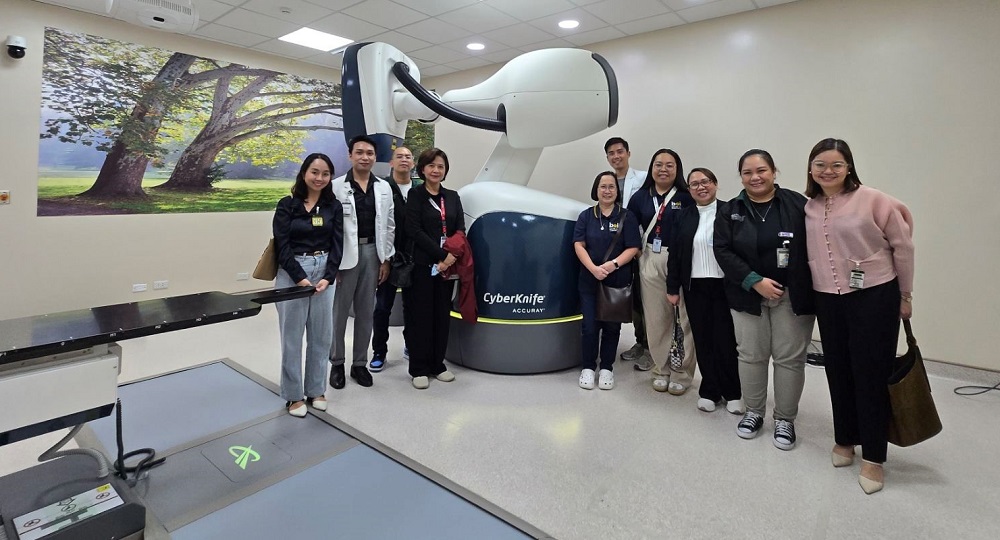Written by Haniel Andrea V. Mizukami | August 27, 2025

Photo Courtesy of Department of Trade and Industry (DTI)
The Knife that Never Cuts: Cyberknife’s High-Tech Precision
WHEN all hope may seem lost, light sheds in the darkness. Cyberknife is an AI-powered radiosurgery technology that aims to treat tumors, both cancerous and non-cancerous. This new treatment arrived in the Philippines and was first introduced at the Asian Hospital and Medical Center in Muntinlupa City last July 28.
While mankind has made a groundbreaking invention for the medical field, two questions remain: What exactly is Cyberknife and will this be the new hope for cancer patients?
A New Era for Radiation Medicine
Cyberknife is a non-invasive technology that was first introduced back in the 1990s, wherein Dr. John Adler, a neurosurgeon based in Stanford, USA, shared his vision and created the system meticulously. Patients can breathe, move their bodies, even cough or relax during the process, as the Cyberknife system is designed to accommodate all forms of patient and tumor movements. In addition, the machine features Synchrony, the only technology in the world that can adjust the radiation in real-time. If a tumor moves, the system can track its movements and synchronize to the target location with precise and high accuracy.
In 2024, Cyberknife celebrated its 30th anniversary of treating their first-ever patient at Stanford University. Although the patient was not named, they became the first stepping stone for the future of Radiation Medicine.
One case that highlighted the effectiveness of Cyberknife is the story of 55-year-old “Danny” who was diagnosed with lung cancer in December 2004. Revealed in his CT scan was a tumor that is said to be the size of a “lime” on his left lung. He had been diagnosed with skin cancer almost four years prior, and a biopsy had revealed that his tumor was malignant.
But with the recommendation of his friend, he had consulted Dr. Brian Berger, a radiation oncologist. Deciding to trust the process, Danny became the first person in the United States to undergo the treatment of the Cyberknife system for lung tumor treatment protocol. In March 2005, patient Danny underwent three treatments that lasted 90 minutes per session. He described how the new technology didn’t hurt and there were no negative aftermaths.
30 days after his treatment, his tumor shrunk at least ninety percent—and after three months, the tumor was completely gone, marking his treatment as a success.
Accuracy With Cost
With its advanced technology, Cyberknife offers flexibility to treat tumors—without making a single incision in the body. But there is one drawback with the machine that every patient needs to consider: the duration of each session.
Each session can prolong to 30 to 90 minutes, although this does not alter the accuracy. In fact, this rechecks its accuracy in every beam made by the machine. Since the radiation is gradually delivered layer by layer across the tumor, Cyberknife is not ideal for very large tumors, as it is less effective for treatment. For this, smaller and recurrent tumors are recommended—other than brain tumors, small tumors in the lung, liver, and spine can be treated effectively using the Cyberknife machine.
New Hope Rises for Filipinos
Although the system celebrated its 30-year anniversary, not all countries in the world have access to this new form of radiation therapy. The Philippines was first introduced to the idea of Cyberknife recently in the Asian Hospital and Medical Center. Dr. Jaymee Fernandez-Ramos, a radiation oncologist, explained the new treatment as a “precise, safe and effective treatment for cancer patients.”
The Cyberknife system wouldn’t require the patients to stay in the hospital overnight. In short, it is an outpatient procedure wherein patients can continue on their day right after receiving the treatment. According to Healthcare Asia, Beaver Tamesis, the Asian Hospital President and CEO, noted that Philhealth benefits could cover as much as 50 percent of the expenses—but the rest of the expenses would be shouldered by the patients. The exact amount of cost wasn't revealed when introducing the new treatment.
Cyberknife is a revolutionary innovation and a vital step forward in the fight against cancer. Its precision and non-invasive approach become proof that hope is never lost, but merely lurking around, waiting to be found. While cost and accessibility are still not guaranteed, its arrival in the Philippines signals a new hope for possibilities for cancer care in the country.
Volume 31 | Issue 2



